How Much Propane Does an RV Fridge Use?
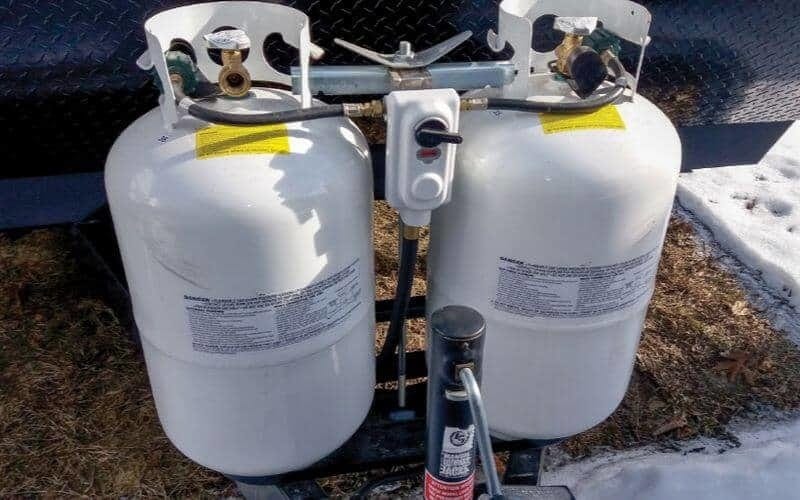
When you’re getting ready to camp in some remote area for an extended period of time, you certainly don’t want to think much about whether you’ll have enough fuel for your RV vehicle. But it is still an important question that you should ask yourself if you do not want the freshness of your food in the refrigerator to be questioned.
Below we bring you useful information about how a propane fridge works and how much propane it uses to work. Once you understand this thing, you will be able to safely go on a pleasant camping trip without much worry about the food you carry with you. So, let’s start!
Table of Contents
How Much Propane Does an RV Fridge Use?
So How Much Propane Does an RV Fridge Use? Typically, an RV fridge with an internal volume of 10 to 12 cubic feet consumes around 1.5 pounds of propane per day which is around 1,400 BTUs per hour. Propane consumption depends on the size and age of the RV’s fridge. However, other factors can also impact the RV refrigerator’s performance.
In this article, you will find useful explanations on how the RV fridge consumes propane and ways you can increase its efficiency. Among other things, we will provide you with an insight into the regular maintenance of the refrigerator and how to organize your food in the RVs refrigerator.
Propane Consumption of a Standard RV Fridge
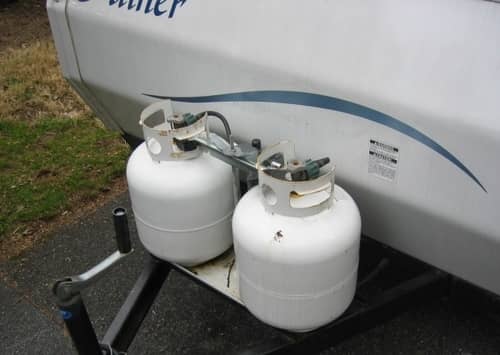
To know exactly how much propane your refrigerator consumes, you must first become familiar with some basic functions. First of all, you need to know exactly how much energy your refrigerator needs to work. The energy consumption of the fridge strongly depends on whether it is an older or newer model of the device.
Newer refrigerators are far more energy-efficient and that’s why they consume less energy. For example, a newer refrigerator with an internal volume that is between 8 and 10 cubic feet has a standard consumption of 1,400 BUTs per hour.
In one gallon of propane, there are 91,000 BTUs of energy. If you have a tank of 20 lb with 4.7 gallons of propane, you can get 427,700 BTUs of energy.
Let’s do the math:
If your fridge in RV runs 24 hours per day it uses 33,600 BTUs each day (24 hours x 1,400 BTUs per hour). With 427,700 BTUs in a 20 lb tank of propane, your fridge can be powered for minimum 12 days (33,600 BTUs daily use/427,700 BTUs in the tank).
However, keep in mind that a large number of refrigerators in the RV don’t work 24/7. Depending on how energy efficient the device is, it can run for around 8 hours per day. Assuming this is the case, your refrigerator with a 20 lb propane tank can run efficiently for a full 38 days, or even longer. What if your refrigerator is smaller in volume? Consider a situation where you have a propane mini-fridge that consumes 600 BUTs per hour. This type of fridge is good in size for storing drinks and necessary groceries.
When a refrigerator works 24/7, its consumption is 14,400 BUTs in one day. If you have a 20 lb tank, the fridge will consume all the fuel in approximately 30 days. But if such a refrigerator works only 8 hours a day, then its daily consumption is 4,800 BUTs, with a tank of propane of 20 lb in it, you can keep food refrigerated for almost 90 days!
So, how long a 20 lb propane tank will run a refrigerator?
If we use the example that we have mentioned above in the article, your RV refrigerator that has a 20 lb propane tank will work efficiently for a little over 38 days or approximately 912 hours. The calculation is simple.
Tip: Look for our guide called How Long Does Propane Last in an RV? The guide includes a calculator with which you can easily calculate the consumption of propane in your refrigerator.
Now it’s time to look at exactly how your RV fridge works so we can figure out how to optimize its efficiency. Although we like to travel with RV to remote and lonely locations, we certainly do not want to carry too much propane on the trip or spend it more than necessary.
How Does a Propane RV Fridge Work?
Unlike a home refrigerator that uses freon to keep food cold, a standard RV refrigerator uses water, ammonia, and hydrogen to work. This combination creates an evaporation effect that is strong enough to draw warm air out of the device and cool it.
While this may sound complicated, it is relatively simple. RV fridge instead of cooling the refrigerator extracts the heat from the device, which is why it is often called an absorption fridge. The base of its work is to absorb heat, and not to create cold temperatures. You don’t understand? Don’t worry, here is the step-by-step explanation that will help you to understand.
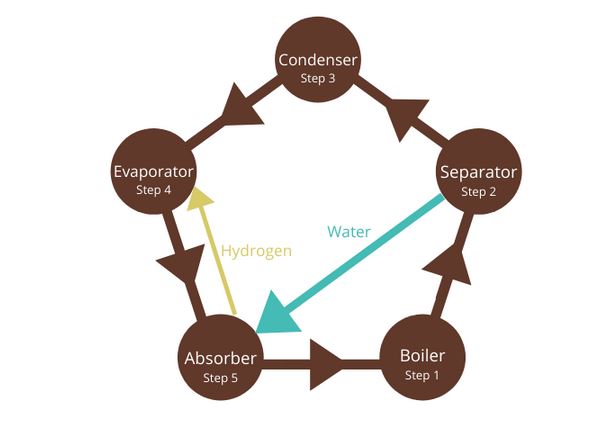
- In a specially-designed boiler, propane heats the ammonia and water blend.
- After, the water and ammonia solution then goes to the separator. Here the ammonia evaporates and then continues through the pipes of the refrigerator. The water goes down towards the absorber.
- The ammonia vapors run into a condenser. Then the condenser pulls out the heat and returns the ammonia back to liquid.
- Now ammonia goes to the evaporator that is placed in the freezer in your RV cooler, and hydrogen adds up. This mixture moves to the evaporator in the cooler portion of the refrigerator. When any heat appears in the freezer, the portion is absorbed and moved to the exterior, leaving the inside of fridge cool!
- After going through both evaporators, the ammonia goes into the absorber. From there, it gets separated from the hydrogen, and after it is mixed with the rest of the water. Then its returned to the boiler.
Related article: How Does An RV Refrigerator Work?
How To Make Propane Fridge More Efficient?
Once you’ve figured out how a propane RV fridge works, it’s time to talk about how to make it more efficient.
1. Regular RV Fridge Maintenance
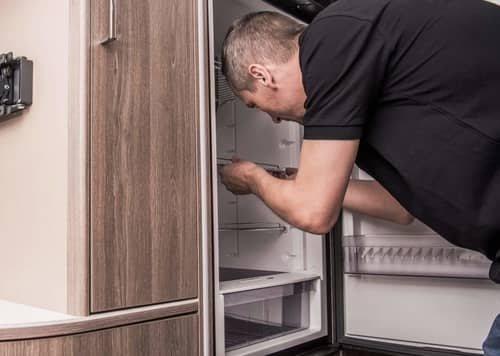
In order for your propane refrigerator to work efficiently, it is important to maintain it regularly. Do the following things:
- Disassemble and then clean the LP gas burner
- Remove deposits of carbon and dust it from the flue baffle and flue
- The ignitor assembly should be cleaned
- Clean and vacuum the condenser fins and cooling units
- Check if there is any leaks in your propane RV fridge and do the adjustment
You don’t have to do this RV fridge maintenance routine every time you go camping. It is enough to do it once a year.
2. Keep Things Level
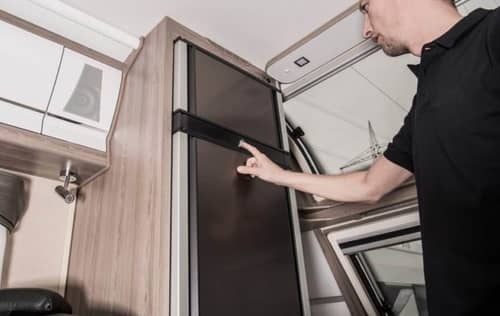
As we have already pointed out, the RV fridge (absorption fridge) uses a combination of liquids to achieve a cooling effect. But in addition, it should be noted that this system relies on gravity. This means that the refrigerator will work best when it is placed on a completely flat surface.
Important: If your RV fridge is not placed so that it is completely flat with the surface, it will not work effectively, and if it is at a higher slope, the device may malfunction. Therefore, before you turn on the refrigerator in your RV with the help of a ruler, make sure that the device is on a flat surface, without tilting.
3. Turn Your RV Fridge Before You Add Food
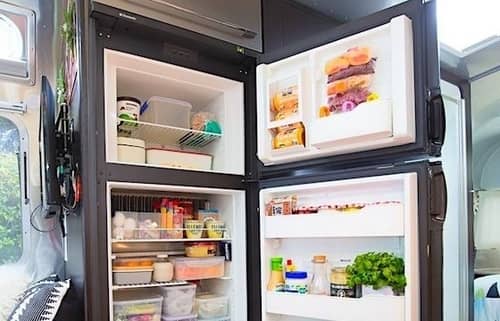
The absorption fridge takes a long time to cool to keep food comfortably cold. In some cases, even more than 24 hours! That is why it is important to cool the refrigerator before putting food in it. Also, when putting food in the fridge, first store the coldest foods. It is a good idea to put ice packs in the fridge if you have them on hand and if there is room for them. All this will help your RV fridge to start cooling at full capacity as soon as possible.
4. Don’t Block the Back of the RV Fridge
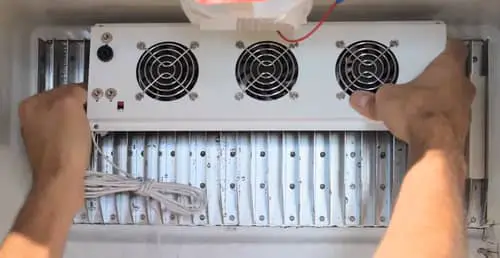
A standard RV refrigerator discharges warm air from the inside through the upper vent, and cold and fresh air enters the refrigerator through a vent located on the back of the appliance. The fridge will not work well if the hot air outlet and cold air inlet are blocked.
With an RV refrigerator, a blocked air vent is a common problem. While driving, the RV passes over various protrusions and holes, which causes the food in the refrigerator to move and can easily block the vent opening. Once you arrive at your destination, be sure to check if this is the case. Also, empty space should be provided between the wall of the RV and the back of the refrigerator, which can be problematic when installing a new appliance.
Each refrigerator model is set up differently when it comes to the back. When a situation arises where you have to put a new one in place of an old refrigerator that has different requirements, installation can be challenging. To ensure maximum energy efficiency in such a situation, be sure to read the manual that came with the refrigerator and move the device away from the wall at the back.
5. Help Circulate The Air
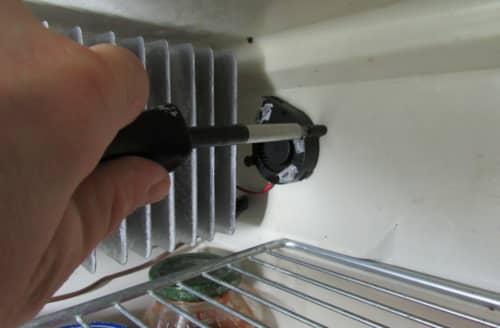
Unlike refrigerators in your home, RV refrigerators usually do not have a built-in fan to ensure air circulation through the appliance. Therefore, if you want to increase the air circulation in the refrigerator, you can install a fan later. Attach the fan to the fridge evaporator fins to ensure even air movement throughout the device.
Tips How To Save Propane On RV Fridges
It is assumed that you have a large fridge in your RV for a lot of groceries if you plan to go camping for a longer period of time to a location that has no electricity. It should be borne in mind that even if you manage to put all the groceries you need for a long time in such a refrigerator, it will be overcrowded. Probably there would not be enough air circulation to make the device energy-efficient enough. In such situations, it is recommended to use several high-quality portable refrigerators that will help keep all necessary food cool when the refrigerator is full.
That way, cold drinks will always be available to everyone. Also, if portable refrigerators contain things you use frequently throughout the day, the refrigerator will open less and be more efficient.
When packing a portable cooler, it is best to coat the inside with ice packs or ice blocks. The use of fast-melting ice cubes is not recommended. In contrast, ice in blocks melts more slowly and cools longer. If the portable cooler is well lined with ice blocks it can stay cold even for several days. If you buy ice along the way and the only thing available to you are ice bags, place them on top of the drinks and food.
Final Thoughts
RV fridge as absorption fridge is an innovation that all campers are glad to have. As with any other appliance, this type of refrigerator will work longer and more efficiently if it is regularly maintained and used carefully. Always fill the refrigerator carefully, cool it well before filling, keep in mind that airflow is ensured and that this appliance must be on a flat surface. If you remember these tips, your RV fridge will work efficiently and consume as little propane as possible while keeping your food well chilled and fresh.
